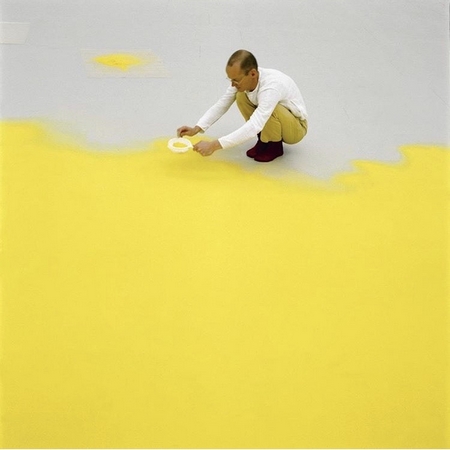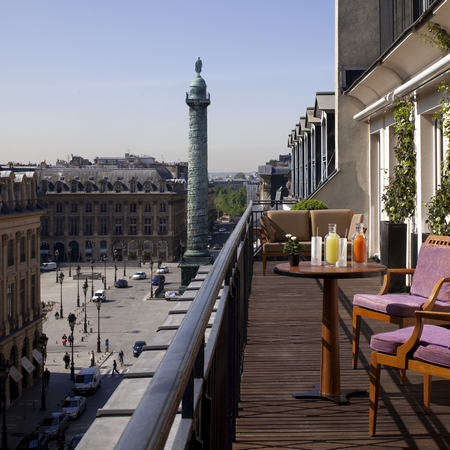The Fondation Louis Vuitton: Bernard Arnault’s dream come true. Making it possible for a wide audience to experience contemporary art in a stunning and unique cultural centre: such is the vocation of the Fondation Louis Vuitton. It is a dream that has taken more than twenty years to come true.
The Fondation is the brainchild of Bernard Arnault, chairman of the LVMH Group, whose dream was to create a new centre devoted to art that would attract visitors from around the world. It would also be a place where artists and public could meet and exchange views as part of an ongoing artistic, cultural and educational programme. The Fondation Louis Vuitton was made possible thanks to the sponsorship of LVMH, its Houses and Louis Vuitton: Houses which, through the excellence of their creations, have not only promoted the art of fine living but have also long harboured humanistic cultural ambitions. The building that houses the Fondation, the first major artistic expression of these ambitions, is the work of architect Frank Gehry. “We wanted to give Paris a very special place for art and culture,” says Bernard Arnaud, “and we made the decision to be bold and exciting by commissioning Frank Gehry to create an iconic 21st century building.ˮ
Finding a site and an architect
The son of an industrialist well known in the construction field, Bernard Arnault has always been passionate about architecture. For many years he has called on a whole new generation of architects in Asia, Europe and the United States to provide buildings for his Houses around the world. But for this Fondation, Bernard Arnault could imagine nowhere else but Paris. The Jardin d’Acclimatation in the Bois de Boulogne, to the west of the city, was a real possibility, and one with deep roots in the Parisian imagination: a place that evoked the magic of childhood and of the city as it was at the end of the nineteenth century. As it happened, LVMH already owned the land of the Jardin d’Acclimatation: it was bought in the 1950s by Marcel Boussac not long after his initial encounter in 1947 with Christian Dior and the creation of his famous fashion house, which was acquired by Bernard Arnault in the 1980s. The place, then, was there, but it needed to be entirely refurbished. The existing buildings had to be demolished and the new one built to within a square metre of the original, in accordance with planning regulations that listed this as a protected site. 11,000 square metres were thus set aside from the twenty hectares of the Jardin d’Acclimatation.
It was after a visit to Bilbao’s Guggenheim Museum that Bernard Arnault became convinced that the project had to be entrusted to the architect Frank Gehry. At the time, the two men were unacquainted, but thanks to Jean-Paul Claverie, the chairman’s adviser, a meeting was arranged in New York in December 2001. Their second meeting three months later in Paris clinched it: Frank Gehry’s visit to the Jardin d’Acclimatation filled him with enthusiasm. This internationally renowned architect has a deep knowledge of French culture: at the drop of a hat, he will talk about Proust, or about the iron and glass structures built in the wake of the Industrial Revolution. Passionately interested in Paris in particular and France in general, he was so moved by Bernard Arnault’s outline of the project that during the eleven-hour flight back to Los Angeles, he filled a whole notebook with sketches! In the course of further meetings between sponsor and architect, an increasingly fascinating and attractive project took shape. The architect lent a sensitive and constructive ear to Bernard Arnault’s ideas. As he himself puts it, he has always designed his buildings in total freedom and with a sense of artistic cohesion. He takes on board all the technical, environmental and administrative constraints and turns them to his advantage. From the start, as soon as Frank Gehry took his first steps in the Jardin d’Acclimatation, he knew he would create a building that would set up a dialogue with nature and with the history of the park, as well as with the glass architecture of the 19th century. Thanks to him, LVMH has acquired a new star and Paris a new and iconic monument.
A very special building
Frank Gehry has designed a building which, in its strength and individuality, follows in the tradition of Parisian monuments. This great vessel covered with twelve glass sails is located in the Bois de Boulogne, next to the Jardin d’Acclimatation. Covering an area of 11,000 square metres, of which 7,000 are open to the public, the building houses eleven galleries devoted to the display of the collections, the contributions of artists, and temporary exhibitions, as well as an auditorium with a flexible layout, capable of seating between 360 and 1,000 people. The terraces afford exceptional views of Paris, La Défense and the surrounding areas, and some also house installations or commissions from contemporary artists. From the top of the Foundation, visitors are able to discover views of Greater Paris that did not previously exist: from the Eiffel Tower to the Bois de Boulogne, from the pigeon house in the Jardin to the skyscrapers of La Défense.
Thanks to its privileged location in this landscaped park, the museum aims to attract both local families and tourists from around the world, as well, of course, as lovers of contemporary art and architecture. Inseparable from the image of its building, the Fondation Louis Vuitton hopes to become both part of the Parisian landscape and an international benchmark in the coming years.
A true architectural feat
From his first sketches, Frank Gehry’s work for the Foundation constituted its inaugural artistic statement. The building he conceived brings together all his methods, codes and means of expression. Through his many scale models, he developed the idea of a building shaped like a boat or ship afloat in its own basin, inseparable from the adjoining waterfall. The choice of materials would express the notion of transparency: the body of the building would be wrapped in glass, giving it its volume and movement. The final scale model was then scanned to provide a digital model of the project. It was above all through his revolutionary work with glass that Frank Gehry brought his vision to life: “Reflecting an endlessly changing world,” he says, “we wanted to conceive a building that varies depending on the hour and the light, in order to create an impression of transience and constant change.” It can confidently be predicted that this bold architectural statement will come to be seen as one of the iconic examples of 21st century architecture.
From the birth of the Fondation Louis Vuitton to its artistic programme
Created in 2006, on the initiative of Bernard Arnault, the Fondation Louis Vuitton marks a new stage in the sponsorship history of the LVMH Group and its Houses, after twenty-five years spent supporting art, culture and heritage in various ways. Five years after meeting Frank Gehry, Bernard Arnault launched his large-scale project: by his side, along with the architect, were Culture Minister Renaud Donnedieu de Vabres, Mayor of Paris Bertrand Delanoë, and the chairman of Louis Vuitton, Yves Carcelle. A corporate foundation and a private cultural initiative, the Fondation Louis Vuitton was born out of a twofold desire. Situated in the heart of Greater Paris, it is part of the cultural landscape of the Ile de France, but also a major act of philanthropy for the city Paris, erecting a very special building on a municipal site, for which a 55-year lease was signed. In its promotion of contemporary artistic creation, the Fondation Louis Vuitton draws on a permanent collection, commissions from artists, as well as temporary exhibitions of modern and contemporary art and multi-disciplinary events. Foremost among its aims is the implementation of an educational programme, especially among the young. As part of the third phase of its inauguration, the Fondation Louis Vuitton is mounting a major exhibition from April 1 to July 6 2015: Les Clefs d’une passion. This historically-informed exhibition gathers together a choice selection of major early-Modernist works that helped to change the course of 20th-century art: from Mondrian to Malevitch and Rothko, from Delaunay to Léger and Picabia, from Munch to Dix and Giacometti, and from Matisse to Kupka and Severini. In accordance with its stated intentions, Les Clefs d’une passion expresses the Foundation’s wish to establish collaborative relationships with other major museums, both in France and internationally.
PORTRAIT: Frank Gehry
Frank Gehry was born in Toronto on February 28 1929 to a family of Polish Jewish origin. His father sold hardware and his mother was a music lover, and this inheritance must surely have fed his sensibility. During his studies in Toronto, engineering, including chemical engineering, was the field he chose. He later studied at the University of Southern California in Los Angeles. He changed his name from Frank Owen Goldberg to Frank Owen Gehry in 1954. After a short spell at the Harvard Graduate School of Design in 1956-57, he went on a long study trip, which included spending time in Paris working with André Remondet. Newly graduated in architecture from USC, he mixed with painters and sculptors and discovered European culture (from Romanesque churches to Le Corbusier), which struck him as very different from the Californian style of architecture with its lack of respect for the environment. Years later, he would sum it up thus: “I was a committed liberal and I loved art, and these two things combined to make me an architect.ˮ Frank Gehry is today considered one of the most important and influential architects of our time. He is known for his personal style of architecture, which incorporates new forms and new materials, and for his unusual sensitivity to the surrounding context. He has been awarded the most prestigious prizes in the architectural field, such as the Pritzker Prize in 1989 and the Japanese Praemium Imperiale in 1992. Today, Gehry Partners, LLP, is based in Los Angeles, and Frank Gehry personally supervises every project developed by his firm for clients around the world. Over the past forty years, he has created many major buildings, mainly in the United States and Europe. Among them, his private residence in Santa Monica (which became his manifesto), the Guggenheim Museum in Bilbao, the DZ Bank Building in Berlin, the Walt Disney Concert Hall in Los Angeles, and the IAC Building and 8 Spruce Street in New York. He has taught at Yale University for several years. On a permanent quest for innovation and meaning, with every project he takes on he pushes back the frontiers of traditional architecture to create buildings full of power and poetry.
Patricia Courcoux Lepic





